
by Elizabeth Atalay | Dec 16, 2014 | 2014, Africa, Awareness, Being Thankful, Casting a Wider Net, Culture, Economy, Eye on Culture, Holiday, Humanitarian, Humanity, India, Inspirational, International, Kenya, Kids, Life, Marketing, Motherhood, Multicultural, ONE, Philanthropy, Poverty, Social Good, Travel, Uganda, Womanhood, Women's Rights, Working Mother, World Voice
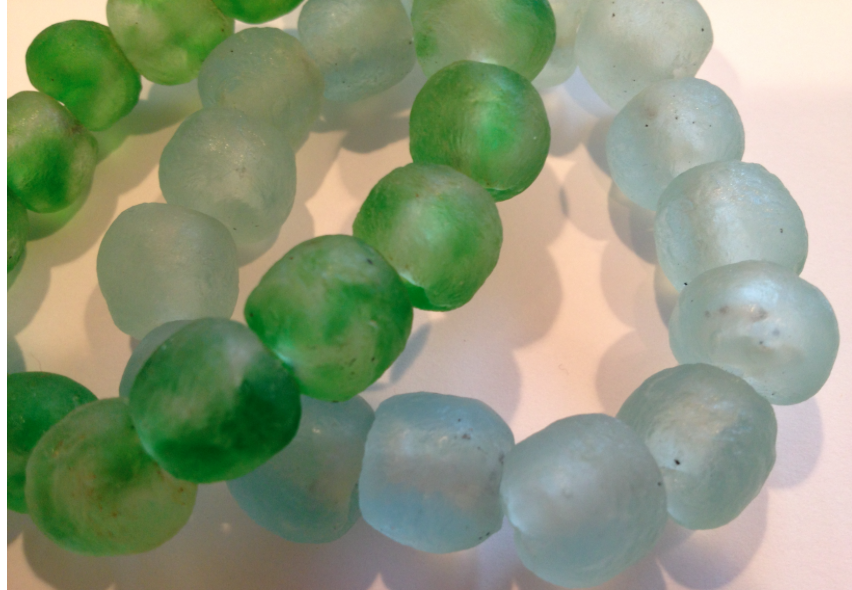
In October, several #WorldMoms attended the ONE Girls & Women AYA Summit at the Google Headquarters in Washington, DC. One of the many powerful panels we heard from was entitled Change Through Economic Opportunity, where both major fashion companies and small start-ups weighed in on how they impact the lives of women through economic empowerment. With the holiday season upon us, World Moms decided to share some of the ways we love to use our purchasing power to give back, and how you can too.

Sydney Price of Kate Spade NY spoke about the Kate Spade On Purpose line at the AYA Summit panel. Each piece in this collection is handcrafted in Rwanda creating sustainable economic opportunities for women and reshaping their community.

 Jane Mosbacher Morris , founder of To the Market, also participated in the panel on Change Through Economic Opportunity at the AYA Summit. To The Market provides a marketplace for the beautiful handcrafted goods that give women survivors of war, disaster or abuse a chance to support themselves and their families.
Jane Mosbacher Morris , founder of To the Market, also participated in the panel on Change Through Economic Opportunity at the AYA Summit. To The Market provides a marketplace for the beautiful handcrafted goods that give women survivors of war, disaster or abuse a chance to support themselves and their families.

 World Moms Elizabeth Atalay and Nicole Melancon had the pleasure of visiting the FashionABLE factory in Ethiopia this past summer and we have all been writing about and wearing the gorgeous scarves made in Ethiopia for years. It was great to finally meet founder Barrett Ward at the AYA Summit this past fall where he participated on the panel as well. FashionABLE is now expanding operations to include products made in Kenya and a beautiful line of leather products, all while providing social service programs of health care, education in a trade, and assistance with child care for their artisans to help them build better lives for themselves and their families.
World Moms Elizabeth Atalay and Nicole Melancon had the pleasure of visiting the FashionABLE factory in Ethiopia this past summer and we have all been writing about and wearing the gorgeous scarves made in Ethiopia for years. It was great to finally meet founder Barrett Ward at the AYA Summit this past fall where he participated on the panel as well. FashionABLE is now expanding operations to include products made in Kenya and a beautiful line of leather products, all while providing social service programs of health care, education in a trade, and assistance with child care for their artisans to help them build better lives for themselves and their families.
“Through your purchase, you are ABLE to provide opportunity, and a woman is ABLE to have a new choice.”-LiveFashionABLE
The Giving Keys provides jobs for those transitioning out of homelessness, giving them the opportunity to rebuild their lives. The necklaces & bracelets are super cool as is the message of the Giving Keys:
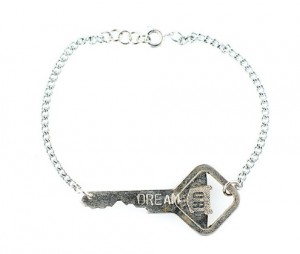
“When you get this Key, you must give it away at some point to a person you feel needs the message, then write us the story of why you gave it away. We employ those looking to transition out of homelessness.” -The Giving Keys
You can read Giving Keys stories of those who have given and received keys on their site.
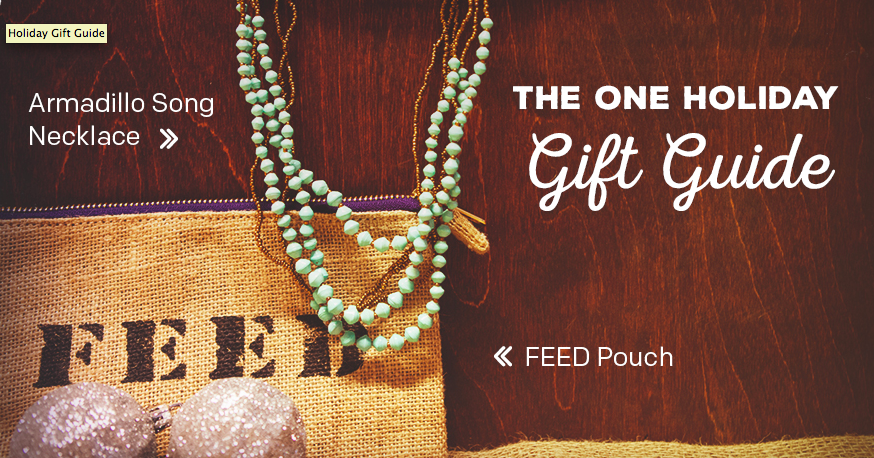
Shop the ONE Campaign store Holiday Gift Guide for some fabulous items where you know everything is fair trade and ethically sourced. By doing so you support the ONE Campaign in it’s goal of eradicating extreme poverty.
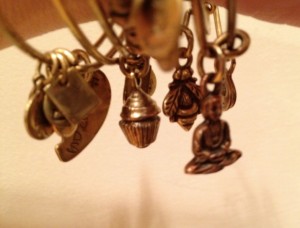
Alex & Ani Bracelets
Alex & Ani Charity by design products are another of our favorites. A percentage o profits goes back to designated non-profits. Their products are made in the USA from recycled materials, and spread the message of positive energy! They have branched out from bangles to key chains, and candles, wine charms & more!
From South Africa, The Mielie bags employ women of the townships in South Africa.
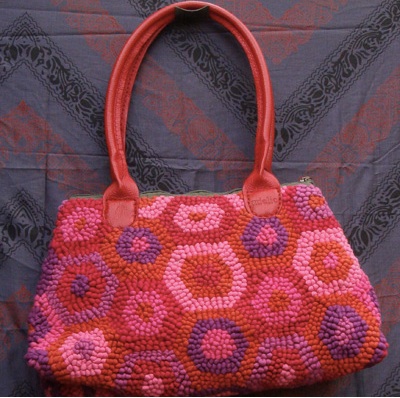
Mielie Bag Made in South Africa
Our mission is to design and produce innovative, export-quality hand-crafted products using reclaimed materials – with the aim of creating employment and restoring dignity and financial independence to South Africans.- Mielie
The Anchal Project Mission merges design, business, and education to empower marginalized and exploited women living in India. Their scarves are gorgeous and the company was founded by two Rhode Island School of design Grads.
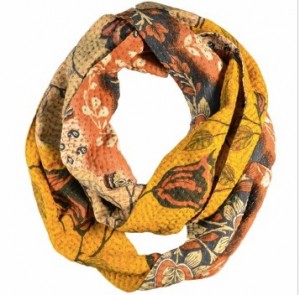
Anchal Scarf
Anchal is an Indian word that means shelter, or refers to the edge of a woman’s Sari used to provide comfort and protection for loved ones.-Anchal Project
Kids Books from Little Pickle Press, a B Corporation, are some of our favorite books for kids!

Lollie Beads Bracelets are created from fair trade recycled glass beads made in Uganda. So they are not only gorgeous (the glass beads look and feel like sea glass) but they are good for the environment AND help support sustainable living in a developing country.

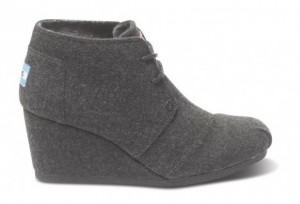 Tom’s keeps its designs fresh while still managing to provide shoes and glasses to those who need them. We love their One for One business model (and pledge to support it with as many shoes as we can get away with!)
Tom’s keeps its designs fresh while still managing to provide shoes and glasses to those who need them. We love their One for One business model (and pledge to support it with as many shoes as we can get away with!)
 1000 Shillings Ugandan Paper bead necklaces. The women artisans earn capital for their own small businesses by making limited-edition products for 1000 Shillings. Each product sold through 1000 Shillings helps a woman establish a small business, which enables her to support her family. They also aim to tell the in-depth story behind each artisan. The company works with six single mothers in the Namatala slum, Uganda.
1000 Shillings Ugandan Paper bead necklaces. The women artisans earn capital for their own small businesses by making limited-edition products for 1000 Shillings. Each product sold through 1000 Shillings helps a woman establish a small business, which enables her to support her family. They also aim to tell the in-depth story behind each artisan. The company works with six single mothers in the Namatala slum, Uganda.
A Gift As A Gesture:
Sometimes it is hard to find the perfect gift for someone who has every material thing they desire. Still you want to give something as a token of your appreciation to them and the below gifts are the perfect solution that everyone can feel good about.
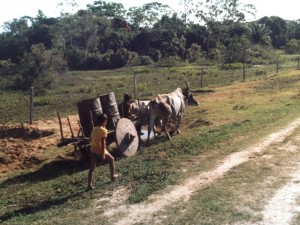
Photo by Elizabeth Atalay
Heifer International :
“Heifer International’s mission is to work with communities to end hunger and poverty and care for the Earth. It all started with a cow. Moved by the plight of orphans and refugees of the Spanish Civil War as he ladled out meager rations of powdered milk, Dan West, an Indiana farmer, volunteer relief worker and Church of the Brethren member, grasped that the people needed “a cow, not a cup”—cows that could produce milk so families would not have to depend on temporary aid. From that simple idea, Heifer International was born.” – From the Heifer International Website
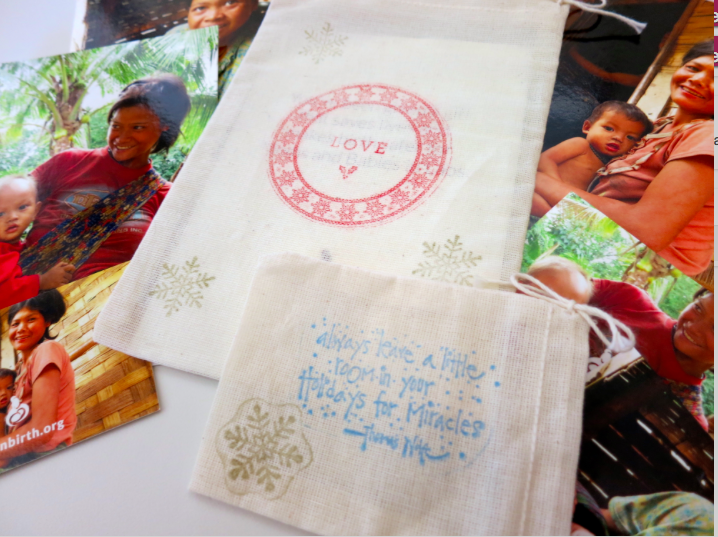 Save two lives, those of a mom and her newborn baby, with CleanBirth.org and the perfect holiday gift of Bags of Love and Miracles, a handmade bag with a beautiful full-sized honor card inside ($20) and 4 mothers in Laos will receive birthing supplies and safe birthing education.
Save two lives, those of a mom and her newborn baby, with CleanBirth.org and the perfect holiday gift of Bags of Love and Miracles, a handmade bag with a beautiful full-sized honor card inside ($20) and 4 mothers in Laos will receive birthing supplies and safe birthing education.

Mom2Mom Africa is a Canadian Not-for-Profit Organization, established to help empower women and children through education. The benefits of education and global awareness apply to us all. Your gifts this season will help to buy books, school uniforms and school supplies for the Mom2Mom Africa students in Tanzania.
Wishing Happy Holidays to You All,
May You Give As Good As You Get!
Do you know other organizations or shops that belong on this list?

Elizabeth Atalay is a Digital Media Producer, Managing Editor at World Moms Network, and a Social Media Manager. She was a 2015 United Nations Foundation Social Good Fellow, and traveled to Ethiopia as an International Reporting Project New Media Fellow to report on newborn health in 2014. On her personal blog, Documama.org, she uses digital media as a new medium for her background as a documentarian. After having worked on Feature Films and Television series for FOX, NBC, MGM, Columbia Pictures, Warner Brothers, 20th Century Fox, and Castle Rock Pictures, she studied documentary filmmaking and anthropology earning a Masters degree in Media Studies from The New School in New York. Since becoming a Digital Media Producer she has worked on social media campaigns for non-profits such as Save The Children, WaterAid, ONE.org, UNICEF, United Nations Foundation, Edesia, World Pulse, American Heart Association, and The Gates Foundation. Her writing has also been featured on ONE.org, Johnson & Johnson’s BabyCenter.com, EnoughProject.org, GaviAlliance.org, and Worldmomsnetwork.com. Elizabeth has traveled to 70 countries around the world, most recently to Haiti with Artisan Business Network to visit artisans in partnership with Macy’s Heart of Haiti line, which provides sustainable income to Haitian artisans. Elizabeth lives in New England with her husband and four children.
More Posts

by Kyla P'an (Portugal) | Dec 11, 2014 | 2014, Adolescence, Awareness, Being Thankful, Bilingual, Cultural Differences, Culture, Education, Eye on Culture, Friendship, Inspirational, International, Japan, Language, Life, Life Lesson, Living Abroad, Multicultural, Parenting, Relationships, Responsibility, Study Abroad, Traditions, Travel, USA, World Motherhood
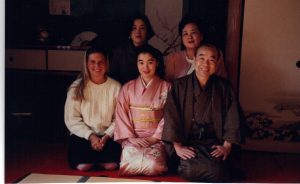
The author with her Japanese host family,
Oshogatsu (New Year’s Day), 1994
When I was eight years old, my mom moved from our home, outside of Philadelphia, Pennsylvania, to start a new life for herself in Los Angeles, California.
Growing up on the East Coast of the US, in the 1970’s, I had been exposed to only small pockets of Asian, immigrant populations; I knew nothing of the large, well-established Asian populations out on the West Coast.
On one of my first trips out to visit, my mom took me to an area of Los Angeles called Little Tokyo. As its name infers, it was a predominantly Japanese neighborhood and wandering around its streets made me feel like I had been transported to a different land.
I can’t remember if I had ever had sushi before my visit but certainly I had never experienced sushi in as authentic a setting as the restaurant she took me to that day.
The entrance involved crossing a wooden bridge over a small koi pond. There were stone lanterns and bonsai trees. the waitresses were all clad in kimono and the sushi arrived at our table on small wooden planks. I was mesmerized. For me, it was love at first…bite.
This experience had such an impact on me that, from that day on, I was enthralled by anything Japanese. I wanted to know everything I could about the country, culture and its people.
The Japanese were the great inventors of all things prominent in my childish memory: Iron Man, Godzilla, Kero-Kero Keroppi, Hello Kitty, my first Walkman. What a genius tribe they must be!
The rise of my curiosity coincided perfectly with the rise of the Japanese economy. Access to their food, products and even language grew increasingly accessible.
When I was in high school, a small group of students expressed their desire to study Japanese, a language option not yet offered at my school. Fortunately for us, since our school was less than an hour from Yale University—one of the US’s leading colleges—we petitioned for and received permission to get transportation to Yale one evening a week, so we could take an introductory-level Japanese language class there.
When I began researching colleges the following year, I selected only those with an established Japanese language program and study abroad opportunities.
I ended up at a small, liberal arts college in Tennessee with a strong International Studies department. I enrolled in every Japanese class they offered. In my sophomore year, I applied for and was accepted into my school’s Japanese exchange program with our sister university in Osaka, Japan.
At the end of my sophomore year, when all students had to declare their majors, I–along with one other student–petitioned for and was granted permission to develop the school’s first degree track in Japanese Studies. It seemed an auspicious plan, considering the Japanese purchase of the iconic, US landmark, Rockefeller Center, earlier that same year.
I spent my entire junior year of college abroad, studying at a Japanese university, living with two separate Japanese families and absorbing as much of the country and culture as possible for a college-aged kid.
I turned 21 there, a major American coming-of-age. I participated on Japanese sports teams, took painting and pottery classes, studied the culture through the fascinating lens of manga (Japanese comics), dated only Japanese men and immersed myself in the pursuit of understanding all things Japanese.

The author and her host sister dressed in kimono
My study abroad experience had an unbelievable impact on my life. It launched my passion and insatiable hunger for travel and Asia, beyond Japan.
I gained greater independence, broadened my global perspectives, forged life-long friendships, developed cultural empathy and experienced life as a minority; a gaijin (outsider) in a homogeneous land.
I consider my study abroad experience the foundation of the life I built upon it. I know that many of us here at World Moms Blog also have had experiences living and studying abroad; it is one of the many ties that bind us. We are global citizens striving to raise our own children in an increasingly globalized world.
But, as you will learn later today from World Moms Blog Founder, Jennifer Burden, here in the US, accessibility to and enthusiasm for studying abroad are not as prevalent as many of us may think.
So what’s it like in your country? Are study abroad programs prolific on your college campuses? Did you benefit from studying abroad? Tell us about what the experience means to you.
And stay tuned later today for Jen’s post on Studying Abroad and how the White House is playing a part…
This is an original post to World Moms Blog from our managing editor and mother of two rising, global citizens, Kyla P’an.
The pictures used in this post are credited to the author.
Kyla was born in suburban Philadelphia but spent most of her time growing up in New England. She took her first big, solo-trip at age 14, when she traveled to visit a friend on a small Greek island. Since then, travels have included: three months on the European rails, three years studying and working in Japan, and nine months taking the slow route back from Japan to the US when she was done. In addition to her work as Managing Editor of World Moms Network, Kyla is a freelance writer, copy editor, recovering triathlete and occasional blogger. Until recently, she and her husband resided outside of Boston, Massachusetts, where they were raising two spunky kids, two frisky cats, a snail, a fish and a snake. They now live outside of Lisbon, Portugal with two spunky teens and three frisky cats. You can read more about Kyla’s outlook on the world and parenting on her personal blogs, Growing Muses And Muses Where We Go
More Posts - Website
Follow Me:


by Shaula Bellour (Indonesia) | Dec 4, 2014 | 2014, Awareness, Being Thankful, Cultural Differences, Domesticity, Expat Life, Family, Home, Husband, Indonesia, International, Kids, Life, Life Balance, Life Lesson, Living Abroad, Motherhood, Parenting, Responsibility, Shaula Bellour, Twins, World Motherhood
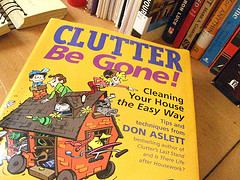 This month marks our third anniversary of living in Jakarta. Considering how empty our house was when we first arrived here, I am staggered at how much stuff we have acquired in that short time.
This month marks our third anniversary of living in Jakarta. Considering how empty our house was when we first arrived here, I am staggered at how much stuff we have acquired in that short time.
We initially started out with garden chairs as living room furniture and took our time furnishing our new space. Though the house isn’t exactly cluttered, it feels full – and I feel daunted by the sheer volume of STUFF that seems to fill every closet and drawer.
It’s the never-ending tide of cheap party favors, orphaned toy and game parts, and plastic galore. It’s the piles of paper: children’s artwork, old receipts, and unfinished magazines. It’s all the things I never use or wear, the boxed objects I might use one day and the stock of (US-bought) items I think I can’t live without.
Moving from the US to East Timor 5 years ago was a great opportunity to clear things out and scale back. Although I did feel a little sad watching an expectant dad cart away our twins’ disassembled cribs the night before we moved, it felt good to sort through our accumulated belongings and assign categories: donate, sell, ship or store.
Donating unwanted items was easy. I arranged for a pick up with a local charity group, stacked everything on my porch and it was all magically whisked away. We sold our car and other big items, sent friends home with plants and other housewares and shipped our edited possessions to Dili.
Everything else went into our storage unit. A few years later I visited it for the first time and was amazed by what we’d deemed worth keeping at the time. I randomly peeked in a few boxes and found…sweaters. Lots of sweaters. What was I thinking? It was winter at the time and we didn’t know how long we’d be away, but still.
We also stored our furniture, though we recently realized that the cost of storing it for the last five years has probably exceeded its value. While visiting the US, my husband spent a day digging out furniture and giving it all away – couches, tables, lamps, washer/dryer…everything. I was thousands of miles away at the time but it felt fantastic.
Leaving East Timor prompted a similar purge. And yet here I am again, feeling the urgent need to reduce and simplify.
Here in Jakarta, this process isn’t as straightforward. While it’s fair to say that nothing will ever go unused, getting rid of unwanted items isn’t as simple as piling them on the porch. I frequently give outgrown kids’ clothes and shoes to friends or neighbors, donate household items to women’s association charity shops, or leave things out to be upcycled by our handcart-pulling bin man.
Last month my children got involved and we went through their toys, books and clothes and filled 10 bags with donations for a local orphanage. Though it was good for them to be part of this process, I would also really like for them to see where their donations are going and consider giving back in other ways (time, money, materials etc.).
Although I will never be a minimalist (or a light packer…), I’m committed to scaling back and am hopeful that this is a first step toward living with less.
A quick internet search reveals hundreds of creative ways to de-clutter, organize and simplify our homes – and ultimately our lives. We are told that having too much stuff is draining and overwhelming us, that we are wasting too much time and money managing our things and that getting rid of all this stuff can make our lives richer and happier.
All of this may be true, but for me the bigger question is about how to acquire less stuff in the first place.
Clearly I don’t have the answer yet, but it’s definitely something I would like to explore and practice – starting now.
Please share your strategies and tips to get me started!
How do you minimize/manage the “stuff” in your house and life? Do you have any tips for living with less?
This is an original post for World Moms Blog by Shaula Bellour.
Shaula Bellour grew up in Redmond, Washington. She now lives in Jakarta, Indonesia with her British husband and 9-year old boy/girl twins. She has degrees in International Relations and Gender and Development and works as a consultant for the UN and non-governmental organizations.
Shaula has lived and worked in the US, France, England, Kenya, Eritrea, Kosovo, Lebanon and Timor-Leste. She began writing for World Moms Network in 2010. She plans to eventually find her way back to the Pacific Northwest one day, but until then she’s enjoying living in the big wide world with her family.
More Posts

by World Moms Blog | Dec 3, 2014 | 2014, Awareness, Being Thankful, Caring, Casting a Wider Net, Economy, Eye on Culture, Guest Post, Helping, Human Rights, Humanitarian, Inspirational, International, Marketing, Motherhood, Multicultural, Philanthropy, Poverty, Rape, Social Equality, Social Good, Social Media, Tragedy, USA, Women's Rights, World Interviews, World Tour
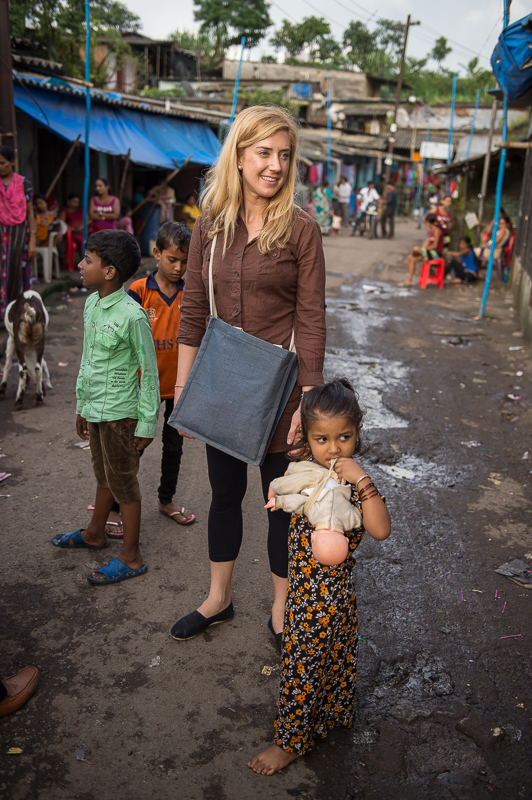
Jane Mosbacher Morris,
Founder of To the Market
What is To the Market and how did it get started?
TO THE MARKET | Survivor-made Goods (TTM) combines the powers of commerce and storytelling to empower the world’s most courageous survivor populations. We’ve developed a three-pronged social enterprise model that we believe reflects the needs of organizations employing survivors of abuse, conflict, or disease to help ensure that these organizations can continue to provide steady work to the survivors.
Our goal is that the survivors in our network eventually achieve economic independence, meaning that they aren’t dependent on someone or something else.
Our model includes (1) promoting survivor-made goods via our multiple distribution channels, including pop-up shops, custom sourcing, retail partnerships, and our online marketplace; (2) offering a platform for survivors and their champions to share their stories through TTM’s Stories and Huffington Post blogs; and (3) providing tailored services, such as trend forecasting and basic mental health resources, to our partners to improve production and management.
I started TTM after a trip to Kolkata, India revealed a way to impact the most vulnerable survivor communities by offering them an opportunity to earn an income.
I saw the light in the eyes of the survivor turned artisans when they were given the chance to earn—they wanted the dignity of work. I began speaking to incredible people all over the globe (including in the U.S.) who had created social enterprises to employ different survivor populations, usually by employing them to produce handicrafts.
I heard really positive feedback about the model of employing survivors (and all of the incredible benefits to the self-esteem and trajectory of the survivor and his or her children). However, I also heard about the challenges of making this model work—TTM aims to help augment these challenges.
Who are the artisans at To the Market?
TTM identifies and teams up with existing organizations currently employing survivors of abuse, conflict, or disease. We call these organizations “local partners”. Local partners consist of non-profits and for-profit social enterprises that have already set up shop, hired, and trained survivors to produce products.
TTM focuses on certain types of survivor populations. This includes, but is not necessarily limited to; survivors of abuse, such as survivors of domestic violence, physical and sexual abuse, and human trafficking; survivors of conflict, such as war widows, refugees, or persons living in conflict/post-conflict states ; or survivors of disease, including populations living with HIV/AIDS, leprosy, or physical disabilities.
We have partners across the globe, including in the U.S., South America, Africa, and Asia.
Do you see a pattern in consumers’ behavior when it comes to shopping responsibly?
I think there is a desire to shop more responsibly, but it often comes down to what people can afford. I am really proud of the fact that our local partners make a variety of products at all different price points—on-trend bracelets for under twenty dollars to timeless cashmere scarves for several hundred dollars.
Can you share a personal story that you think best represents the mission of the online shop?
I recently spent nearly a month in Nepal and India visiting with many of our local partners. I was particularly reminded of how transformational economic independence can be to these survivors when I spent time with their children—their daughters, especially. Most of the survivors we work with are women. When the women achieve economic independence, their daughters are so much less likely to be exploited. We recently wrote about a shelter in New Delhi, India that employs HIV/AIDs infected and affected women. You can see the video about the shelter and read about it on our Stories blog here.
How did you get involved with this work?
I began my career in counterterrorism with a focus on the intersection of women and security. Much of my mission was to try to elevate the role of women in national security-related issues, but I consistently found that women with some form of economic independence had so much more leverage in their family, community, and country than those with none.
That (five year) experience got the wheels turning quickly about the importance of economic independence in empowering vulnerable populations. When I went to work for the McCain Institute on human trafficking, I really saw how vital it was for survivors of some sort of trauma (whether it be abuse, conflict, or disease) to have access to some income.
It brings me extraordinary joy to be a part of the life-changing process of gaining even the slightest bit of independence.
What are your favorite picks for this holiday season?
- For Mom: I love this 100% cashmere scarf hand spun by master spinners in the Kashmir Valley! Each scarf contains the women’s initials that made it.
- For Dad: I love this red spice and merlot trivet. It’s the perfect size for cuff links, receipts, or coins and is neutral enough to sit comfortably on a nightstand or office desk. It’s hand-woven by craftswomen in Rwanda.
- For college kids: I have to suggest the patrice signature bag, which I am currently carrying by No41. It has two major points of impact!
- First, it provides a stable job and sustainable income to a young woman transitioning into a life of independence from living in an orphanage in Rwanda.
- SECOND (and perfect for the college student), it provides 240 meals to a secondary student in Rwanda!
- For kids: I love these brightly colored elephant ornaments (in pink or blue) hand-sewn by women in the Ivory Coast. Pink and blue patterns make it easy to pick for a boy or girl.
- For the office or book/dinner club gift exchange: I selected either a Sari Coin Purse hand-sewn by human trafficking survivors in Kolkata, India or this Hope Ornament pounded out of recycled metal oil drums in Haiti. Even if you don’t have a tree, you can hang this Hope sign up to encourage you! Both come in under $10, the perfect price point for small gifts.
- I am also including a couple “splurge on yourself “ items because I feel like most moms that I know only spend on others! I’ve included the Holiday Festive skirt, because it’s the perfect pattern for this time of year and also because it’s made by stay-at-home moms in Belize who are caring for sick children. Or, this Soledad Peru bag. The Suede straps and bottom make it strong enough to carry six wine bottles (yes, please!). The bag was made by women weavers in a valley deeply scarred by the Shining Path.
How can World Moms help spread the word about shopping responsibly this holiday season and beyond?
What a great question! Helping to get the word out about social enterprises like TO THE MARKET via social media and blogging is a tremendous help, in itself. Someone doesn’t have to have a huge following, either! Just telling your family or friends that these social enterprises exist makes a difference. So much of why so many social enterprises struggle is because they don’t have the marketing budget that big box retailers have to tell their story. There is nothing more flattering (or effective) than a personal referral!
This is an original interview with To the Market founder, Jane Mosbacher Morris, for World Moms Blog. You can learn more about the good work and great products To The Market sells by visiting their website (http://www.tothemarket.com/goods)
The image in this post is used by permission from To the Market.
World Moms Blog is an award winning website which writes from over 30 countries on the topics of motherhood, culture, human rights and social good. Over 70 international contributors share their stories from around the globe, bonded by the common thread of motherhood and wanting a better world for their children.
World Moms Blog was listed by Forbes Woman as one of the "Best 100 Websites for Women 2012 & 2013" and also called a "must read" by the NY Times Motherlode in 2013. Our Senior Editor in India, Purnima Ramakrishnan, was awarded the BlogHer International Activist Award in 2013.
More Posts

by World Moms Blog | Dec 2, 2014 | 2014, Health, Hospital, Humanitarian, International, Social Good, World Moms Blog
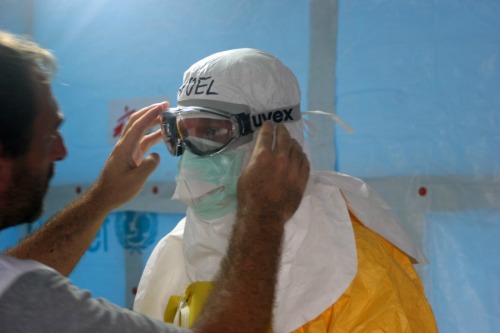
World news cycles through our Facebook feeds, blogrolls, and across our Television screens at lightning speed these days. Just four weeks ago most of our nation was riveted by the play by play updates about Ebola, and it was impossible to escape the news. Was Ebola coming to the US? Would there be a domestic outbreak? Did the CDC make the right calls once it was here? Were the health workers who contracted the disease while risking their lives treating those struggling going to survive? Should there be a travel ban? Would there be a vaccine? Ebola was everywhere! Then, even before the last American infected left the hospital a healthy man, Ebola all but disappeared from the news.
But here is the thing, Ebola itself did not disappear at all. Instead, it continues to threaten the lives of tens of thousands of people in West Africa and has already taken the lives of over 5,000 men, women, and children. 5000. Think about that number for a second; the reverberating loss that number represents. Thousands of spouses lost the love of their life, thousands of families lost a brother, a sister, a son, a daughter, an aunt, an uncle, a friend. Thousands of children lost their mothers or fathers or almost incomprehensibly both of their parents to this disease.
It is not stopping. It is not slowing down. It is only getting worse.
People are dying in the streets while they wait for treatment. There are not enough beds for the sick, supplies for the clinics, or medical professionals on the ground to gain control of the situation. They need our help, and they need it now.
The founding members of WGIRLS INC, each thankful for the opportunities their respective upbringings provided, came together to create a way for women to express that gratitude through service to those less fortunate. We create and deliver programming and fundraising initiatives that support access to safe housing, creature comforts, medical care, education, and career opportunity for those less fortunate. While WGIRLS chapters focus primarily upon efforts in their respective local communities, in times of international crisis, we come together to raise awareness and funding for those in need wherever that need may be.
This holiday season, many of us will gather around tables to give thanks for our blessings, spend time laughing and sharing with friends and family and exchanging gifts with our loved ones. At the same time, however, some of our brothers and sisters in West Africa will be desperately seeking medical care to survive. For them there will be no hugs or loved ones surrounding them. There will be no celebrations or laughter, but there is an opportunity for a gift. The gift of a fighting chance against Ebola.
Doctors without Borders, the premier organization in the fight against the disease is in desperate need of additional funding. As one of the few non-governmental organizations treating Ebola in West Africa their resources have been stretched to the limit attempting to treat the sick and control the disease.
A gift of your support will help provide the funding needed for additional medical personnel, treatments, beds, tents, and medical supplies.
Most importantly, your gift will give hope to the thousands of families impacted by this deadly disease.
Thank you in advance for joining us in the fight! Happy Holidays to you and yours!
You can DONATE HERE this #GivingTuesday.
This is an original post written for World Moms Blog by Amy Heller of WGirls in New York, USA.
Photo: Médecins Sans Frontières and American CDC staff preparing to enter an Ebola treatment unit in Liberia via wikipedia
World Moms Blog is an award winning website which writes from over 30 countries on the topics of motherhood, culture, human rights and social good. Over 70 international contributors share their stories from around the globe, bonded by the common thread of motherhood and wanting a better world for their children.
World Moms Blog was listed by Forbes Woman as one of the "Best 100 Websites for Women 2012 & 2013" and also called a "must read" by the NY Times Motherlode in 2013. Our Senior Editor in India, Purnima Ramakrishnan, was awarded the BlogHer International Activist Award in 2013.
More Posts
by Mama B (Saudi Arabia) | Nov 26, 2014 | Adolescence, Awareness, Boys, Brothers, Culture, Education, Eye on Culture, Family, Gender, Girls, Husband, International, Life Lesson, Motherhood, Older Children, Parenting, Puberty, Relationships, Saudi Arabia, School, Teenagers, Womanhood, World Motherhood
I grew up in a house full of girls with one baby brother, who was so much younger than me that our friends and social lives didn’t overlap.
Now that I am the mother of three boys and one girl, I am learning many things I never knew about boys: they are more straightforward, easier to read, and, honestly, easier to persuade than girls. Boys wrestle–a lot. Even when they haven’t got the hang of walking yet, they wrestle. (I still don’t know why.) Boys are more emotional than I expected, and more sensitive.
I know there’s a lot more to learn about raising boys, and I’m excited to do it–especially because I can call in their father whenever something freaks me out.
Despite my growing expertise in raising boys, something recently caught me off guard. Something obvious in our society, but not so prevalent in my ‘tribe’ (which is what I call my close family–mother, father, aunts, uncles, cousins, etc.).
My eldest turned 11 this year, and is in the phase between boy and teenager. And I find myself surprised to discover that our society’s segregation of men and women is changing my relationship with my own son.
I was totally unprepared for the separation that occurred when he moved from the little school to the big school. I went from being able to walk into his class, to speak to his teacher, and to meet his friends and their moms, to having to drop him off and pick him up outside the school gate (but not right in front of it, where the other boys could see us).
No more going into the school, unless I make an appointment with the headmaster and go to his office to speak with the teachers. (And even that is not permissible in most boys’ schools, the majority of which would not even allow a woman on the premises. The same is true for girls’ schools, which don’t permit men on the premises.)
My son can no longer go into the all-women area of the malls. In a few years, he won’t be allowed in any area of the mall without a ‘family’ for fear he will terrorize the girls. (Ironically, some young teenagers wait outside the malls and approach older women, or women with children, and ask them to pretend they are one family to gain entrance into the mall.)
Soon, my son won’t invite his friends over when his sister is home, although he could still invite cousins and close family friends.
There are so many unwritten rules concerning the separation of girls and boys, and a million variations. For some families, it’s pretty black and white: unless he is your brother or father, or unless she is your sister or mother, you don’t spend time with them. It also depends upon the region. In the eastern or western provinces, strict segregation is not as prevalent as it is here in the central region. In seacoast areas, people have the benefit of interacting with many cultures, and are therefore more forgiving.
I am baffled by how our society has become so segregated. Throughout the early history of Islam, segregation wasn’t practiced. Modesty and chastity, yes. Total segregation, no. I do not even think it was part of our culture as Saudis. At least, not to the extent it is today.
Until recently, Bedouin women were expected to welcome travelers into their tents, and to make them coffee, and even dinner, regardless of whether her husband was there. Yes, most would have had their faces covered (again, a cultural custom, not religious one), but they interacted with men all the time. It’s only in recent years that things have changed. Some put it down to the influences that came into Saudi when it was united. Others say it is a reaction to how fast we were exposed to the outside world, and how quickly we went from tribal life to modern-day life.
Theories aside, I’m facing the reality of being shut out of a part of my son’s life and of him being shut out of mine.
When I explained my concern to one of his teachers (over the phone) he said, “You can’t follow him around all of his life!” As if I were a stalker! Am I being a stalker? Hmmm, I wonder how involved I would be in his day-to-day school life if I were?
My biggest fear is that if he gets caught up in the wrong crowd, segregation makes it easier in certain houses with absent fathers to make mistakes and do stupid stuff. I thank God his father keeps an eye on him, and that he still fills me in about his day and talks to me when he is upset. If we can continue to talk, I think I may be okay.
Perhaps I just don’t like not being in control of the situation, or perhaps it’s that I don’t have the choice.
Would you naturally step back from your son’s day-to-day life when he turns 11 or 12? Would you withdraw from knowing his friends and supervising his outings?
It’s all foreign territory for me now, and I am learning to deal with it as best I can.
This is an original post to World Moms Blog from our contributor in the Kingdom of Saudi Arabia and mother of four, Mama B.
Photo credit: Dr. Coop under Flickr Creative Commons License

Mama B’s a young mother of four beautiful children who leave her speechless in both, good ways and bad. She has been married for 9 years and has lived in London twice in her life. The first time was before marriage (for 4 years) and then again after marriage and kid number 2 (for almost 2 years). She is settled now in Riyadh, Saudi Arabia (or as settled as one can be while renovating a house).
Mama B loves writing and has been doing it since she could pick up a crayon. Then, for reasons beyond her comprehension, she did not study to become a writer, but instead took graphic design courses. Mama B writes about the challenges of raising children in this world, as it is, who are happy, confident, self reliant and productive without driving them (or herself) insane in the process.
Mama B also sheds some light on the life of Saudi, Muslim children but does not claim to be the voice of all mothers or children in Saudi. Just her little "tribe." She has a huge, beautiful, loving family of brothers and sisters that make her feel like she wants to give her kids a huge, loving family of brothers and sisters, but then is snapped out of it by one of her three monkeys screaming “Ya Maamaa” (Ya being the arabic word for ‘hey’). You can find Mama B writing at her blog, Ya Maamaa . She's also on Twitter @YaMaamaa.
More Posts




 Jane Mosbacher Morris , founder of To the Market, also participated in the panel on Change Through Economic Opportunity at the AYA Summit. To The Market provides a marketplace for the beautiful handcrafted goods that give women survivors of war, disaster or abuse a chance to support themselves and their families.
Jane Mosbacher Morris , founder of To the Market, also participated in the panel on Change Through Economic Opportunity at the AYA Summit. To The Market provides a marketplace for the beautiful handcrafted goods that give women survivors of war, disaster or abuse a chance to support themselves and their families.
 World Moms Elizabeth Atalay and Nicole Melancon had the pleasure of visiting the FashionABLE factory in Ethiopia this past summer and we have all been writing about and wearing the gorgeous scarves made in Ethiopia for years. It was great to finally meet founder Barrett Ward at the AYA Summit this past fall where he participated on the panel as well. FashionABLE is now expanding operations to include products made in Kenya and a beautiful line of leather products, all while providing social service programs of health care, education in a trade, and assistance with child care for their artisans to help them build better lives for themselves and their families.
World Moms Elizabeth Atalay and Nicole Melancon had the pleasure of visiting the FashionABLE factory in Ethiopia this past summer and we have all been writing about and wearing the gorgeous scarves made in Ethiopia for years. It was great to finally meet founder Barrett Ward at the AYA Summit this past fall where he participated on the panel as well. FashionABLE is now expanding operations to include products made in Kenya and a beautiful line of leather products, all while providing social service programs of health care, education in a trade, and assistance with child care for their artisans to help them build better lives for themselves and their families.
 Tom’s keeps its designs fresh while still managing to provide shoes and glasses to those who need them. We love their One for One business model (and pledge to support it with as many shoes as we can get away with!)
Tom’s keeps its designs fresh while still managing to provide shoes and glasses to those who need them. We love their One for One business model (and pledge to support it with as many shoes as we can get away with!) 1000 Shillings Ugandan Paper bead necklaces. The women artisans earn capital for their own small businesses by making limited-edition products for 1000 Shillings. Each product sold through 1000 Shillings helps a woman establish a small business, which enables her to support her family. They also aim to tell the in-depth story behind each artisan. The company works with six single mothers in the Namatala slum, Uganda.
1000 Shillings Ugandan Paper bead necklaces. The women artisans earn capital for their own small businesses by making limited-edition products for 1000 Shillings. Each product sold through 1000 Shillings helps a woman establish a small business, which enables her to support her family. They also aim to tell the in-depth story behind each artisan. The company works with six single mothers in the Namatala slum, Uganda. Save two lives, those of a mom and her newborn baby, with CleanBirth.org and the perfect holiday gift of Bags of Love and Miracles, a handmade bag with a beautiful full-sized honor card inside ($20) and 4 mothers in Laos will receive birthing supplies and safe birthing education.
Save two lives, those of a mom and her newborn baby, with CleanBirth.org and the perfect holiday gift of Bags of Love and Miracles, a handmade bag with a beautiful full-sized honor card inside ($20) and 4 mothers in Laos will receive birthing supplies and safe birthing education.





















